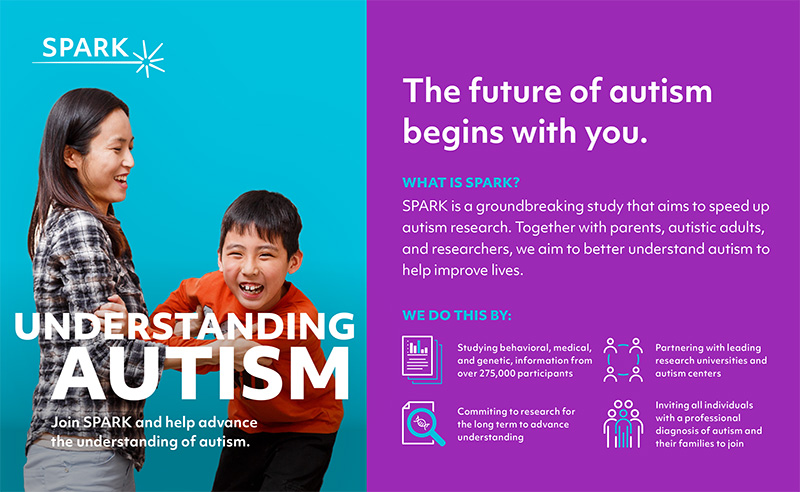This article has information about suicide and suicide prevention. For help 24/7, please call or text the U.S. Suicide and Crisis Lifeline at 988.
Few people used to think about the risk of suicide among people on the autism spectrum. Researchers rarely studied it. Primary care doctors did not routinely ask about it. Most families had no idea that their sons and daughters with autism faced any particular risk of suicide.

But that has changed in the past decade. A growing number of research studies have found that autistic youth and adults appear to have higher rates of suicidal thoughts, plans, or behaviors than other people do. As a group, their suicide risk may be two to seven times higher than the risk for youth and adults who do not have autism.1-5
Suicide is a major public health issue in the U.S. population as a whole, according to the U.S. Centers for Disease Control and Prevention. In 2019, suicide was the second leading cause of death for people ages 10 to 34. More than 47,000 people of all ages died by suicide that year. Many, many others thought about it or made an attempt.
“It’s an incredibly serious public health threat to our country and worldwide,” says clinical psychologist Lisa M. Horowitz, PhD, MPH, who researches suicide prevention at the U.S. National Institute of Mental Health (NIMH). “What we know about people with autism is that they are at higher risk for many other medical conditions, so it follows that they may also be at higher risk for suicide,” she explains.
Horowitz notes that research is lagging, especially in children on the spectrum.
As a society, we have been slow to focus upon suicide and suicide prevention, particularly among people with autism and neurodevelopmental conditions, says Paul H. Lipkin, MD, a pediatric neurodevelopmental specialist and director of medical outpatient services at Kennedy Krieger Institute in Maryland. Lipkin is researching suicide prevention in autism and developmental conditions.
Decades ago, people who were diagnosed with autism often also had severe developmental delays, Lipkin says. Their doctors and families may have believed that they were unlikely to attempt suicide, he says.
“But that thought has been dispelled more recently through public awareness and by research that shows that, in fact, not only can teens and adults on the spectrum have suicidal thoughts and behaviors, but even children can have those same thoughts,” Lipkin says. “Suicidal behavior may in fact be a leading cause of injury and death in the autism community, and more needs to be done about this.”
What the Research Shows
Several studies published in the last 10 years have examined suicide risk in people on the spectrum. One study published in 2020 stands out for its size. In Sweden, researchers identified 54,000 autistic people using medical records from 1987 through 2013 and compared them to 271,000 people who do not have autism.1 Researchers use a comparison, or control, group to see if having a particular condition or treatment affects an outcome.
In the Swedish study, researchers also included thousands of people who have a relative with autism, along with more than 1 million people who do not have autistic family members.1
Researchers found the highest rate of suicide attempts and death by suicide among autistic people who do not have intellectual disability. Within that group, the autistic people with attention deficit hyperactivity disorder, or ADHD, had the highest rate of all. About 1 in 10 of them had attempted suicide, a rate that is seven times higher than the comparison group.
Autistic people who have intellectual disability also had a higher risk of suicide attempts, about double the risk of the comparison group.
The study findings were startling for girls and women. One in five females who had both autism and ADHD (but not intellectual disability) had attempted suicide at least once. Other studies have not found a higher risk in girls and women, although they were not as large as the Swedish study.
When researchers took into account psychiatric conditions that increase suicide risk, such as depression, anxiety, and substance abuse disorders, autistic people still had a higher risk than the comparison group.
The researchers also found a higher risk of suicidal behavior in the close relatives of people on the spectrum – parents, siblings, and children – than in the comparison group. That suggests that family risk factors, along with mental health conditions, may contribute to the risk of suicidal behavior in autistic people, the study says.
What Puts Autistic People at Risk?
What else might help explain the risk of suicidal thoughts and behaviors in autistic people?
Some of the risk factors for suicide in the general population occur more frequently in people with autism, although researchers do not know for sure if these factors have the same influence on autistic people.6 For example:
- Children with autism are bullied more than their peers.7 Research shows that both bullies and their victims have a higher risk of suicidal thoughts and behaviors.8
- Autistic people have higher rates of underemployment or unemployment than the general population.9
- Youth and adults on the autism spectrum have higher rates of mental health conditions, such as depression, bipolar disorder, schizophrenia, anxiety, and ADHD, than other people.2, 10, 11
Learning Who Might Be at Risk
How do you know if someone is thinking about suicide? According to Lisa Horowitz of NIMH, “The best way to identify someone at risk for suicide is to ask them directly.”
Some families worry that youth on the spectrum might start thinking about suicide if a healthcare provider asks about it. Studies of people who do not have autism show that it is safe for a trusted adult to ask about thoughts of suicide, Horowitz says. Research that might shed more light on this issue with autistic youth is underway.
In the meantime, providers balance a family’s concerns and the higher risks for suicidal thoughts and behaviors in these youth, says clinical psychologist Jessica Schwartzman, PhD, who researches depression and suicidal thoughts in autistic people at Vanderbilt University Medical Center. Research shows that autistic teens and adults “are much more likely to have thoughts about dying,” she says. “So I think it’s important to screen and ask about these thoughts directly with patients.”
What if an Autistic Youth Mentions Suicide?
Listen to a child who brings up the subject, Horowitz says. “We need to take all talk of suicide seriously, and pay attention to it,” she says. “While suicide is a very rare event, if a child is talking about thoughts of suicide or wanting to kill themselves, it’s important to say things that make them feel less alone.” For example, the adult could say, “‘I’m glad you are telling me. I take this very seriously. My first priority is keeping you safe, and I want to be able to help you. We will get through this together,’” she says.
Parents can seek help from their children’s doctor or therapist, and by calling or texting the U.S. Suicide and Crisis Lifeline at 988. If they believe their children may try to harm themselves in the near future, parents can take them to the emergency room, she says.
Families are not the only ones who can be alert for suicidal thoughts in people with autism.
Doctors can play an important role in suicide prevention, says Paul Lipkin, the doctor at Kennedy Krieger. The American Academy of Pediatrics, a professional association of pediatricians, recommends that doctors screen all youth ages 12 and older for suicide risk.
Lipkin, Horowitz, and others want to make it easier for those doctors and clinics to find out if youth with autism and developmental disorders have suicidal thoughts. They are working on a study of the effectiveness of a suicide risk screening tool specifically for these youth. Another study, led by researchers at University of North Carolina and University of Pennsylvania, is looking at ways to adapt a suicide prevention intervention for autistic teens and young adults.
Resources
- For help 24/7, please call or text the Suicide and Crisis Lifeline at 988 or call 1-800-273-8255. Online chat available.
- Text TALK to 741741 to reach the Crisis Text Line.
- Read the American Academy of Pediatrics’ Blueprint for Youth Suicide Prevention.
- People in the SPARK autism study have participated in studies of mental health and suicidal thoughts through Research Match.
To learn more, see the next article in this series, “Working to Prevent Suicide in Youth with Autism.”
Interested in joining SPARK? Here’s what you should know.
This article has been republished with permission from SPARK. You may view the original article, published on September 7, 2022, at https://sparkforautism.org/discover_article/autism-suicide-risk/.
Footnotes
- Hirvikoski T. et al. Psychol. Med. 50, 1463-1474 (2020) PubMed
- Croen L.A. et al. Autism19, 814-823 (2015) PubMed
- Chen M.H. et al. J. Clin. Psychiatry 78, e1174-e1179 (2017) PubMed
- Kirby A.V. et al. Autism Res. 12, 658-666 (2019) PubMed
- O’Halloran L. et al. Clin. Psychol. Rev. 93,102144 (2022) PubMed
- Hedley D. and M. Uljarevic Curr. Dev. Disord. Rep.5, 65-76 (2018) Abstract
- Hoover D.W. and J. Kaufman Curr. Opin. Psychiatry31, 128-132 (2018) PubMed
- Holt M.K. et al. Pediatrics135, e496-509 (2015) PubMed
- Roux A.M. et al.National autism indicators report: Vocational rehabilitation. Philadelphia, PA: Life Course Outcomes Research Program, A.J. Drexel Autism Institute, Drexel University (2016)
- Fombonne E. et al. J. Autism Dev. Disord. 50, 3679-3698 (2020) PubMed
- Zheng Z. et al. Autism Res.11, 1110-1119 (2018) PubMed






